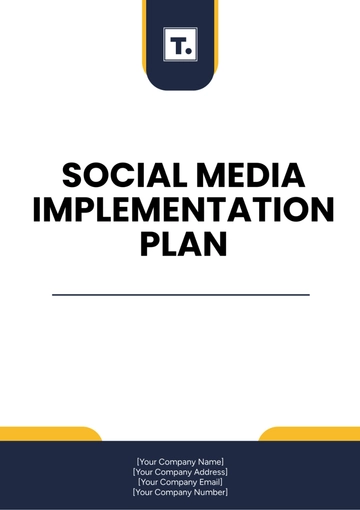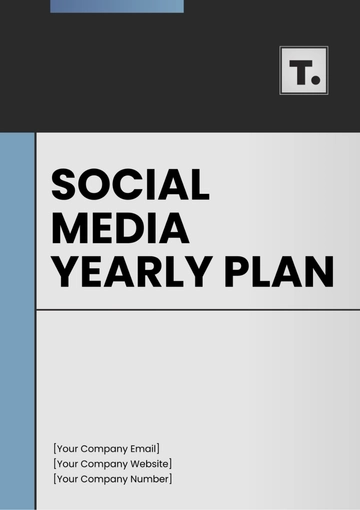Free Social Media Marketing Budget Plan

Introduction
Welcome to [Company Name]'s Social Media Marketing Budget Plan. This comprehensive guide is designed to serve as the cornerstone for all financial decisions related to our social media marketing efforts. In an era where social media platforms are constantly evolving, along with their respective advertising options, having a meticulous and well-thought-out budget is not just beneficial—it's crucial for long-term success.
Managing a budget in the dynamic landscape of social media marketing can be challenging. Costs can fluctuate based on platform changes, audience targeting parameters, and the competitive environment. Therefore, this document aims to provide a structured approach to budget allocation, expense tracking, and financial performance metrics. It will help you understand how much is being spent, where it is being spent, and what returns are being realized from those investments.
Beyond just numbers and figures, this budget plan aligns closely with [Company Name]'s strategic objectives and marketing goals. Whether we aim to increase brand awareness, boost user engagement, drive website traffic, or improve conversion rates, each aspect of the budget is fashioned to support these overarching goals. By following this plan, team members can make informed decisions that contribute not only to the success of our social media campaigns but also to the growth and profitability of [Company Name] as a whole.
Objectives
The Social Media Marketing Budget Plan seeks to address multiple facets of budget management to ensure that [Company Name]'s financial resources are used effectively and strategically. The primary objectives that guide this budget plan are as follows:
Cost-Effectiveness. The goal of cost-effectiveness is not merely about reducing expenses but about attaining the highest possible return on investment (ROI). The landscape of social media marketing is filled with myriad opportunities, each with its own cost structure and potential for returns. Therefore, this plan aims to guide the allocation of funds in a manner that prioritizes avenues offering the highest ROI. Every expense line item will be scrutinized to make sure it aligns with achieving maximum effectiveness for the least cost. By employing a disciplined approach to spending, we can aim for scalability and long-term sustainability in our social media marketing initiatives.
Alignment. Alignment with overall marketing and business goals is vital for any budget plan to be considered successful. A disjointed budget plan could lead to wastage of resources and missed opportunities. This document serves as a strategic roadmap to ensure that each aspect of our social media spending is in sync with [Company Name]'s broader marketing objectives. Whether our focus is on increasing brand awareness, enhancing customer engagement, or generating high-quality leads, each budget allocation is designed to serve these larger goals directly.
Flexibility. While planning is essential, the ability to adapt is equally important, especially in the ever-changing social media landscape. Our budget plan is constructed with flexibility in mind, allowing for reallocation of resources based on performance metrics and changing market conditions. If a specific campaign is outperforming expectations, funds can be quickly shifted to capitalize on this success. Conversely, underperforming initiatives can be scaled back or terminated to avoid further wastage of resources. This agile approach to budgeting allows us to remain nimble and make data-driven decisions that enhance overall performance.
Scope
The Social Media Marketing Budget Plan for [Company Name] aims to provide a comprehensive overview of all budgetary considerations needed for successful and efficient social media marketing. The scope of this plan extends across multiple dimensions of financial allocations, ensuring that every potential expense is anticipated and strategically managed. Here are the key areas the budget plan encompasses:
Paid Advertising. This category involves expenses related to sponsored posts, pay-per-click (PPC) campaigns, and other forms of paid promotions across social media platforms such as Facebook, Instagram, Twitter, and LinkedIn. Given that paid advertising is often the most substantial part of a social media marketing budget, it's essential to allocate funds judiciously. The aim is to identify the most cost-effective advertising options that align with our target audience and marketing objectives.
Content Creation. Effective social media marketing hinges on high-quality, engaging content. This section allocates budget for content creation, which may include graphics, videos, blog posts, and other forms of multimedia content. The costs may involve hiring content creators, graphic designers, video editors, or investing in software that aids content creation. This part of the budget ensures that the content not only aligns with the brand but is also captivating enough to engage the audience.
Social Media Tools. Managing multiple social media accounts, analyzing metrics, and scheduling posts require the use of specialized software and tools. This budget line item accounts for subscriptions or licenses for social media management platforms, analytics tools, and other software that streamline the workflow and provide insights into performance metrics.
Employee Costs. The human element can't be ignored in social media marketing. From strategists and managers to customer service representatives, the budget must account for the salaries or fees for those responsible for executing and managing the social media marketing plan. This might also include training costs to keep the team updated on the latest social media trends and tools.
Miscellaneous Expenses. In addition to the clearly defined categories, a provision for miscellaneous expenses is also included. This may cover unforeseen costs such as premium stock images, emergency campaigns, or unplanned software upgrades. A certain degree of flexibility will be maintained in this category to accommodate unexpected opportunities or challenges.
By carefully planning and allocating funds across these key areas, [Company Name] aims to create a holistic and efficient budget plan capable of driving successful social media marketing initiatives.
Budget Allocation
The Budget Allocation chapter provides a detailed financial blueprint for [Company Name]'s Social Media Marketing initiatives. In this section, we break down the various categories that require funding and allocate specific budgets to each. The aim is to ensure a balanced and effective distribution of resources, thereby optimizing the Return on Investment (ROI) and achieving our outlined marketing objectives.
Here, you'll find a systematic allocation of funds across essential categories such as Paid Advertising, Content Creation, Social Media Tools, Employee Costs, and Miscellaneous Expenses. By outlining these costs in advance, we not only set a fiscal roadmap but also offer a structured approach for periodic review and adjustment. This allows for better management and reallocation of funds based on performance metrics and evolving marketing strategies.
The total budget earmarked for our social media marketing endeavors is $26,000. This amount has been allocated after careful consideration of all potential expenses and expected returns, ensuring that each dollar spent contributes to meeting or exceeding our marketing objectives.
Social Media Marketing Budget Allocation Table:
Category | Allocation |
Paid Advertising | $10,000 |
Content Creation | $5,000 |
Social Media Tools | $2,000 |
Employee Costs | $8,000 |
Miscellaneous | $1,000 |
Total | $26,000 |
Payment Methods
In an effort to simplify the financial transactions and accommodate various preferences, [Company Name] offers multiple payment options for covering the allocated social media marketing budget. Payments can be made through [insert payment methods here], such as bank transfers, credit cards, digital wallets, or any other agreed-upon methods. It's crucial for all stakeholders to be aware of these options to ensure smooth and timely financial operations. The chosen payment methods aim to offer a balance between convenience and security, adhering to financial regulations and compliance standards. This section serves as a reference point for understanding the avenues available for fulfilling financial commitments related to our social media marketing initiatives.
Monitoring and Metrics
Continuous monitoring and metrics analysis are pivotal to the successful execution of [Company Name]'s Social Media Marketing Budget Plan. To ensure we are maximizing ROI while adhering to the allocated budget, a series of key performance indicators (KPIs) will be closely scrutinized. These KPIs include but are not limited to Cost Per Click (CPC), Conversion Rate, and Customer Acquisition Cost (CAC).
Frequent financial check-ins will be conducted, typically on a weekly or bi-weekly basis, to assess our spending patterns against anticipated returns. This approach allows us to make real-time adjustments to the budget allocations and make informed decisions about scaling or pausing campaigns. The Cost Per Click (CPC) serves as a tangible measure of how effectively our advertising budget is converting into actual traffic. Likewise, Conversion Rate helps us understand the percentage of that traffic that takes the desired actions, such as making a purchase or signing up for a newsletter. Customer Acquisition Cost (CAC) is another crucial metric, providing insights into the overall efficiency of our marketing efforts by quantifying the average cost to acquire a new customer.
Collectively, these metrics create a robust framework for financial oversight, ensuring that each dollar spent is contributing to the achievement of our marketing objectives.
Roles and Responsibilities
Effective budget management in social media marketing requires a multi-disciplinary approach, involving various stakeholders within the organization. Each role carries specific responsibilities aimed at ensuring the budget is not only well-planned but also well-executed and monitored for effectiveness. The roles and responsibilities are clearly delineated to eliminate any ambiguity and to streamline the budget management process.
Role & Responsibility Table:
Role | Responsibility |
CEO | Responsible for the final approval of the budget, ensuring it aligns with broader company goals and strategies. |
CFO | Conducts a comprehensive financial review of the budget, making sure it's financially viable and responsible. Advises on potential adjustments to optimize ROI. |
Marketing Manager | Takes charge of implementing the budget, tracking expenditures, and making real-time adjustments based on KPI performance. |
[Accounting Department] | Handles all invoicing and payments, ensuring that expenditures are accurately recorded and reconciled with the approved budget. Additionally, flags any discrepancies for immediate resolution. |
Additional Information:
CEO: As the ultimate decision-maker, the CEO will also receive periodic updates on budget performance and may advise on major reallocations, if needed.
CFO: Alongside financial review, the CFO also plays an advisory role, providing data-driven insights for potential reallocations to improve marketing effectiveness.
Marketing Manager: This role also encompasses coordination with other departments to ensure that the budget is in sync with marketing campaigns, ad buys, and other initiatives.
Accounting Department: Apart from handling invoices and payments, the accounting department will also generate monthly financial reports to facilitate budget tracking and review.
By clearly defining these roles and responsibilities, [Company Name] aims to establish a smooth, transparent, and effective budgeting process for our social media marketing endeavors.
Appendix A: Sample Budget Breakdown
Below is a sample table offering a detailed, line-by-line breakdown of all budgeted costs. This table is an indispensable tool for maintaining transparency and accountability in our social media marketing budget.
Item | Category | Budget Allocation | Details | Responsible Department |
Facebook Ads | Paid Advertising | $3,000 | PPC and boosted posts | Marketing |
Google Ads | Paid Advertising | $2,000 | Search and display ads | Marketing |
LinkedIn Sponsored Content | Paid Advertising | $1,500 | Sponsored articles and posts | Marketing |
Instagram Ads | Paid Advertising | $3,500 | Image and video ads | Marketing |
Graphic Design | Content Creation | $2,000 | Design for social media posts and ads | Creative Team |
Copywriting | Content Creation | $1,500 | Copy for ads and social media posts | Creative Team |
Stock Photos | Content Creation | $1,500 | Licensing for stock images | Creative Team |
Analytics Tool | Social Media Tools | $1,000 | Subscription to analytics platforms | Marketing |
Scheduling Tool | Social Media Tools | $1,000 | Subscription to scheduling tools | Marketing |
Salaries | Employee Costs | $6,000 | Monthly salaries for social media team | HR |
Bonuses | Employee Costs | $2,000 | Performance-based bonuses | HR |
Contingency | Miscellaneous | $1,000 | Unforeseen costs and overages | Accounting |
Total Budget: $26,000
This sample budget breakdown serves as a template for allocating, tracking, and managing costs. It is recommended that each department review their respective line items and update them as required.
Appendix B: Payment Schedule
The following table outlines the payment schedule for various budget items. This calendar serves as a roadmap to ensure timely payments, thereby maintaining good relationships with vendors and avoiding late fees.
Payment Item | Amount Due | Due Date | Payment Method | Responsible Department | Status |
Facebook Ads | $3,000 | 2023-11-05 | Credit Card | Accounting | Pending |
Google Ads | $2,000 | 2023-11-10 | Bank Transfer | Accounting | Pending |
LinkedIn Sponsored Content | $1,500 | 2023-11-15 | Credit Card | Accounting | Pending |
Instagram Ads | $3,500 | 2023-11-20 | Bank Transfer | Accounting | Pending |
Graphic Design | $2,000 | 2023-11-25 | Credit Card | Accounting | Pending |
Copywriting | $1,500 | 2023-12-01 | Bank Transfer | Accounting | Pending |
Stock Photos | $1,500 | 2023-12-05 | Credit Card | Accounting | Pending |
Analytics Tool | $1,000 | 2023-12-10 | Bank Transfer | Accounting | Pending |
Scheduling Tool | $1,000 | 2023-12-15 | Credit Card | Accounting | Pending |
Salaries | $6,000 | 2023-12-20 | Direct Deposit | HR | Pending |
Bonuses | $2,000 | 2023-12-25 | Direct Deposit | HR | Pending |
Contingency | $1,000 | 2023-12-30 | Bank Transfer | Accounting | Pending |
It is the responsibility of the Accounting Department to ensure that all payments are made before or on the listed due dates. Failure to make timely payments may result in service disruptions, additional costs, or reputational damage. Therefore, maintaining an accurate payment schedule is crucial for effective budget management.
For any queries or clarifications, please contact [Your Company Number].
Document Created on: August 02, 2050
Document Last Updated on: October 13, 2050
- 100% Customizable, free editor
- Access 1 Million+ Templates, photo’s & graphics
- Download or share as a template
- Click and replace photos, graphics, text, backgrounds
- Resize, crop, AI write & more
- Access advanced editor
Elevate your social media marketing strategy with our customizable Social Media Marketing Budget Plan Template. Crafted by experts at Template.net, this editable resource empowers professionals to optimize their keyword targeting and allocate resources effectively. Seamlessly tailor your budget with our AI Editor Tool, streamlining your marketing efforts for maximum impact.
You may also like
- Finance Plan
- Construction Plan
- Sales Plan
- Development Plan
- Career Plan
- Budget Plan
- HR Plan
- Education Plan
- Transition Plan
- Work Plan
- Training Plan
- Communication Plan
- Operation Plan
- Health And Safety Plan
- Strategy Plan
- Professional Development Plan
- Advertising Plan
- Risk Management Plan
- Restaurant Plan
- School Plan
- Nursing Home Patient Care Plan
- Nursing Care Plan
- Plan Event
- Startup Plan
- Social Media Plan
- Staffing Plan
- Annual Plan
- Content Plan
- Payment Plan
- Implementation Plan
- Hotel Plan
- Workout Plan
- Accounting Plan
- Campaign Plan
- Essay Plan
- 30 60 90 Day Plan
- Research Plan
- Recruitment Plan
- 90 Day Plan
- Quarterly Plan
- Emergency Plan
- 5 Year Plan
- Gym Plan
- Personal Plan
- IT and Software Plan
- Treatment Plan
- Real Estate Plan
- Law Firm Plan
- Healthcare Plan
- Improvement Plan
- Media Plan
- 5 Year Business Plan
- Learning Plan
- Marketing Campaign Plan
- Travel Agency Plan
- Cleaning Services Plan
- Interior Design Plan
- Performance Plan
- PR Plan
- Birth Plan
- Life Plan
- SEO Plan
- Disaster Recovery Plan
- Continuity Plan
- Launch Plan
- Legal Plan
- Behavior Plan
- Performance Improvement Plan
- Salon Plan
- Security Plan
- Security Management Plan
- Employee Development Plan
- Quality Plan
- Service Improvement Plan
- Growth Plan
- Incident Response Plan
- Basketball Plan
- Emergency Action Plan
- Product Launch Plan
- Spa Plan
- Employee Training Plan
- Data Analysis Plan
- Employee Action Plan
- Territory Plan
- Audit Plan
- Classroom Plan
- Activity Plan
- Parenting Plan
- Care Plan
- Project Execution Plan
- Exercise Plan
- Internship Plan
- Software Development Plan
- Continuous Improvement Plan
- Leave Plan
- 90 Day Sales Plan
- Advertising Agency Plan
- Employee Transition Plan
- Smart Action Plan
- Workplace Safety Plan
- Behavior Change Plan
- Contingency Plan
- Continuity of Operations Plan
- Health Plan
- Quality Control Plan
- Self Plan
- Sports Development Plan
- Change Management Plan
- Ecommerce Plan
- Personal Financial Plan
- Process Improvement Plan
- 30-60-90 Day Sales Plan
- Crisis Management Plan
- Engagement Plan
- Execution Plan
- Pandemic Plan
- Quality Assurance Plan
- Service Continuity Plan
- Agile Project Plan
- Fundraising Plan
- Job Transition Plan
- Asset Maintenance Plan
- Maintenance Plan
- Software Test Plan
- Staff Training and Development Plan
- 3 Year Plan
- Brand Activation Plan
- Release Plan
- Resource Plan
- Risk Mitigation Plan
- Teacher Plan
- 30 60 90 Day Plan for New Manager
- Food Safety Plan
- Food Truck Plan
- Hiring Plan
- Quality Management Plan
- Wellness Plan
- Behavior Intervention Plan
- Bonus Plan
- Investment Plan
- Maternity Leave Plan
- Pandemic Response Plan
- Succession Planning
- Coaching Plan
- Configuration Management Plan
- Remote Work Plan
- Self Care Plan
- Teaching Plan
- 100-Day Plan
- HACCP Plan
- Student Plan
- Sustainability Plan
- 30 60 90 Day Plan for Interview
- Access Plan
- Site Specific Safety Plan





























